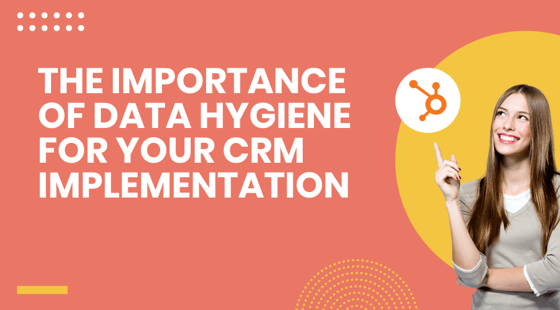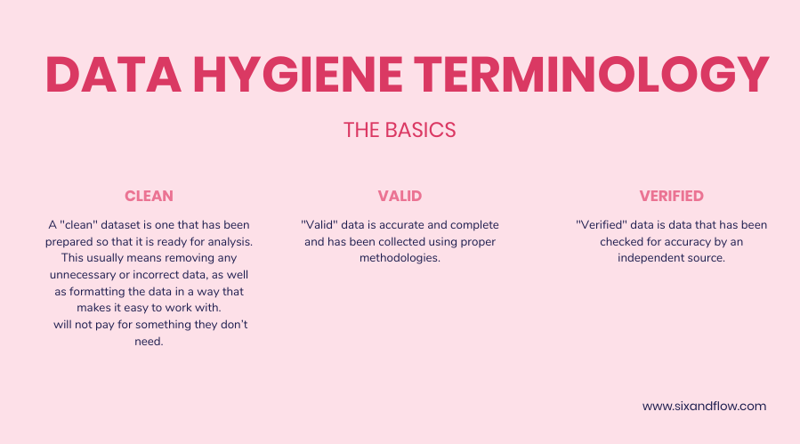


The importance of data hygiene for your CRM implementation




In the world of business, data is everything. It's what we use to make informed decisions, target our advertising efforts, and track our progress - all of which, a CRM can help us with.
It's important that our data be clean and accurate.
Unfortunately, many businesses don't take the time to properly maintain their data - a mistake that can lead to inaccurate reports, lost sales opportunities and even decreased profits. And, when it comes time to implement a CRM or maintain an up-to-date CRM, poor data hygiene can hinder your business's objectives.
What is data hygiene?
Data hygiene is an umbrella term that encompasses the various stages of rendering a dataset more correct, more complete, and fit for purpose.
This means ensuring that data is accurately entered, free of duplicates and errors, and properly formatted.
Good data hygiene is essential for any organisation that relies on data for decision-making. Without clean data, it can be difficult to track progress, identify trends, and make sound decisions.
Data hygiene also helps to protect against security risks, such as leaked data. By regularly scrubbing your databases, your organisations can help ensure that the data is reliable and secure.
Why do we need good data hygiene?
The "why?" is simple; data is used to meet an objective. If data is incorrect, incomplete, or illegible (for either people or computers), then it cannot be used to meet that objective. As is often said in the field of computing:
"Garbage in, garbage out."
Defining the terminology in your organisation.
Terms like "clean", "good", "valid", and "verified" are often used interchangeably. However, in practice, these are very different things.
In your organisation, it is best to have a general sense of the processes that exist and to be aware that someone might have - in their head - a slightly different definition when discussing "clean" data.
But that being said, here are some standard definitions you can use to get everyone aligned.

Defining "Clean" data:
A "clean" dataset is one that has been prepared so that it is ready for analysis. This usually means removing any unnecessary or incorrect data, as well as formatting the data in a way that makes it easy to work with.
Defining "Valid" data:
"Valid" data is accurate and complete and has been collected using proper methodologies.
Defining "Verified" data:
"Verified" data is data that has been checked for accuracy by an independent source.
Maintaining data hygiene for your CRM implementation
Unfortunately, it’s too easy to be buried by an uncontrollable, ever-growing pile of inaccurate data that overwords your CRM.
Data gets outdated. Naming conventions are not upheld, a tech stack is updated, and your data set becomes unstructured.
So, how do you escape this ever-impending doom of poor data hygiene?
Step 1: Inspect
Problem statement:
There is an existing dataset (either in our CRM, or about to be entered into our CRM) that we do not know the size, shape, or cleanliness of.
Steps we take to address the problem:
Also known as 'data exploration', inspecting the data involves looking at the data in its current state, forming an understanding of it, how it relates to other datasets, searching for errors, and assessing it against the data quality dimensions.
For our technical gurus, the inspect stage includes the following activities:
Profiling:
A summary statistic that reveals column types, completeness, no. of unique values, their mathematical distribution, and potential relationships with other data sources
Tidying:
By standardising the format of our data, it is easier to perform all subsequent actions, including visualisation and cleaning.
Mapping:
Information coming from outside the CRM needs to match the fields inside the CRM. Mapping is a process that straddles both the Inspect and the Clean stages; It involves aligning new data to existing structures and adding/removing Properties to meet the CRM owner’s needs. This can be as simple as identifying format changes (splitting a Full Name field to match HubSpot’s First Name and Last Name structure) or as complex as creating entirely new Custom Objects, with their own unique relationships.
Step 2: Clean
Problem statement:
There is an existing dataset (either in our CRM, or about to be entered into our CRM) that is missing information, and/or is improperly formatted. This is negatively impacting our existing work within the CRM, or our ability to import the dataset into the CRM.
Steps we take to address the problem:
Cleaning data also involves a variety of activities, appropriate for different datasets. Generally speaking, incorrect data is either removed, corrected, or imputed through a combination of manual intervention and smart data wrangling tools. During the cleaning stage, we take action to make sure that data meets the relevant dimensions of data quality. Things to look for include:
Mapping, continued:
After conceptually mapping out which fields match, we must reformat our data into a format that suits the CRM. This can involve simple best practices like renaming columns to ease the import process, or more complex operations like differentiating different objects that once existed in the same table (e.g. tagging “Head Offices” separately from their outlet locations, or splitting internal contacts from Marketing contacts. etc.)
Irrelevant data:
Data that isn't needed under the context of the problem we're solving. Oftentimes, when migrating from one CRM to another, there will be years of historical data that is no longer relevant (e.g. a field that denotes whether a user “Attended Convention April 2015”)
Duplicates:
Where information across an entire row appears more than once. In a CRM, this will typically take the form of an individual or company that appears separately against separate email addresses. Depending on the context, duplicates can either be stripped out or collapsed into a single record.
Syntax errors:
Leading or trailing whitespace should be removed and alternative names should be standardised (U.S.A Vs. US).
Standardise:
Formatting for text and numbers should be consistent, whichever format you decide on (Properly Capitalised, UPPERCASE, lowercase, camelCase, etc.)
Step 3: Verify
Problem statement:
Can we confirm that our data is valid (i.e. correct, as far as we can make it) and cleaned?
Steps we take to address the problem:
Verification:
Verification is the process of checking the correctness of the dataset. This typically occurs throughout the exploration and cleaning process, as well as afterwards.
Verifying data can involve checking against other existing records to assess their accuracy, as well as performing operations to check that cleaning has been a success. Do logical rules and constraints (like Start Dates coming before Expiry Dates) hold? Have errors slipped through? Is there another dataset we can cross-reference? For example, if our CRM has a live connection to a database, are we seeing the same information across both systems?
What are the effects of poor data hygiene in your CRM?
We've done a lot of talk about having clean data for your CRM implementation.
But, what if you've had your CRM for a while - what happens when you have bad CRM data?
In simple terms - Interactions and reporting will be flawed.
In today's digital era, personalisation is everything. We personalise our automated emails, the content visitors see on webpages, and the videos we send. Now, what happens if you call a Mr. a Ms. or send somebody an email they shouldn't have received.
You lose trust and credibility.
The goal of your CRM is to act as a "single source of truth" for all customer interactions. This means that your data needs to be cleansed and accurate so that the right information is available to the right people at the right time.
It's best to do a data cleanse at least once a year.
And, when you aren't cleansing your data, maintain those standardised rules you set out in your original CRM Implementation.
Data hygiene best practices for your CRM implementation
As a good starting point, here are some best practices your organisation can implement to maintain data hygiene:
- Use naming conventions
- Standardise data collection processes
- Introduce automation to remove old, unengaged contacts
- Set up a maintenance schedule
- Introduce admin rules and user permissions for data entry







